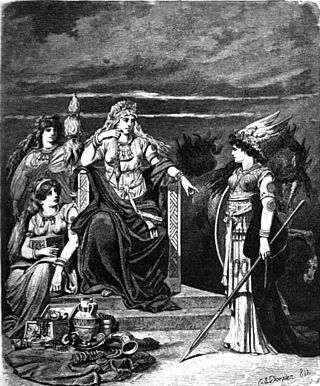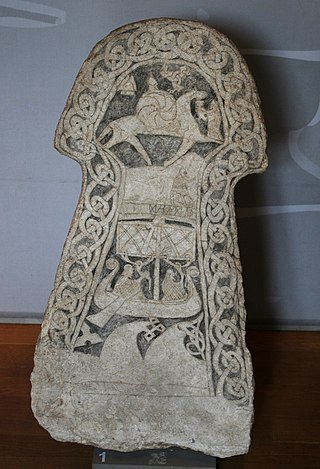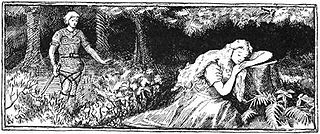
In Norse mythology, Brísingamen is the torc or necklace of the goddess Freyja, of which little else is known for certain.

Bragi is the skaldic god of poetry in Norse mythology.

The Norns are deities in Norse mythology responsible for shaping the course of human destinies.

Yggdrasil is an immense and central sacred tree in Norse cosmology. Around it exists all else, including the Nine Worlds.

A dwarf is a type of supernatural being in Germanic folklore. Accounts of dwarfs vary significantly throughout history; however, they are commonly, but not exclusively, presented as living in mountains or stones and being skilled craftsmen. In early literary sources, only males are explicitly referred to as dwarfs. However, they are described as having sisters and daughters, while male and female dwarfs feature in later saga literature and folklore. Dwarfs are sometimes described as short; however, scholars have noted that this is neither explicit nor relevant to their roles in the earliest sources.

In Norse mythology, Hlín is a goddess associated with the goddess Frigg. Hlín appears in a poem in the Poetic Edda, compiled in the 13th century from earlier traditional sources, the Prose Edda, written in the 13th century by Snorri Sturluson, and in kennings found in skaldic poetry. Scholars have debated whether the stanza referring to her in the Prose Edda refers to Frigg. Hlín serves as a given name in Iceland, and Hlín receives veneration in the modern era in Germanic paganism's modern extension, Heathenry.

In Norse mythology, Eir is a goddess or valkyrie associated with medical skill. Eir is attested in the Poetic Edda, compiled in the 13th century from earlier traditional sources; the Prose Edda, written in the 13th century by Snorri Sturluson; and in skaldic poetry, including a runic inscription from Bergen, Norway from around 1300. Scholars have theorized about whether these three sources refer to the same figure, and debate whether Eir may have been originally a healing goddess or a valkyrie. In addition, Eir has been compared to the Greek goddess Hygieia.

The Poetic Edda is the modern name for an untitled collection of Old Norse anonymous narrative poems in alliterative verse. It is distinct from the closely related Prose Edda, although both works are seminal to the study of Old Norse poetry. Several versions of the Poetic Edda exist: especially notable is the medieval Icelandic manuscript Codex Regius, which contains 31 poems.

In Norse mythology, a valkyrie is one of a host of female figures who guide souls of the dead to the god Odin's hall Valhalla. There, the deceased warriors become einherjar. When the einherjar are not preparing for the cataclysmic events of Ragnarök, the valkyries bear them mead. Valkyries also appear as lovers of heroes and other mortals, where they are sometimes described as the daughters of royalty, sometimes accompanied by ravens and sometimes connected to swans or horses.

Máni is the Moon personified in Germanic mythology. Máni, personified, is attested in the Poetic Edda, compiled in the 13th century from earlier traditional sources, and the Prose Edda, written in the 13th century by Snorri Sturluson. Both sources state that he is the brother of the personified sun, Sól, and the son of Mundilfari, while the Prose Edda adds that he is followed by the children Hjúki and Bil through the heavens. As a proper noun, Máni appears throughout Old Norse literature. Scholars have proposed theories about Máni's potential connection to the Northern European notion of the Man in the Moon, and a potentially otherwise unattested story regarding Máni through skaldic kennings.
Various gods and men appear as sons of Odin in Old Norse and Old English texts.

Sól or Sunna is the Sun personified in Germanic mythology. One of the two Old High German Merseburg Incantations, written in the 9th or 10th century CE, attests that Sunna is the sister of Sinthgunt. In Norse mythology, Sól is attested in the Poetic Edda, compiled in the 13th century from earlier traditional sources, and the Prose Edda, written in the 13th century by Snorri Sturluson.

In Norse mythology, Billingr or Billing is the father of a maiden desired by Odin. According to stanzas 96-102 of the poem Hávamál from the Poetic Edda, Odin was told by the maiden to meet her after nightfall when it would be safest and she would give herself to him, but when Odin returned he found the path blocked by warriors with swords and burning torches. When he came back at daybreak he discovered that the maiden was gone and had left a female dog tied to the bed in her place. In this way Odin was thwarted in his attempts to possess the girl. The episode is narrated in the first person by Odin himself and used by him as an example of the supposed fickleness and deception of women, and he laments the folly of longing for that which is unobtainable.

Hamdir, Sörli, and Erpr were three brothers in Germanic heroic legend who have a historic basis in the history of the Goths.

In Norse mythology, four stags or harts eat among the branches of the world tree Yggdrasill. According to the Poetic Edda, the stags crane their necks upward to chomp at the branches. The morning dew gathers in their horns and forms the rivers of the world. Their names are given as Dáinn, Dvalinn, Duneyrr and Duraþrór. An amount of speculation exists regarding the deer and their potential symbolic value.
In Norse mythology, Durinn is a dwarf according to stanza 10 of the poem Völuspá from the Poetic Edda, and repeated in Gylfaginning from the Prose Edda. He was the second created after the first and foremost dwarf Mótsognir.
Dúrnir was a dwarf who appears in the three Old Norse skaldic poems which suggests that he once was a well-known dwarf in Norse mythology.

Norse, Nordic, or Scandinavian mythology, is the body of myths belonging to the North Germanic peoples, stemming from Old Norse religion and continuing after the Christianization of Scandinavia as the Nordic folklore of the modern period. The northernmost extension of Germanic mythology and stemming from Proto-Germanic folklore, Norse mythology consists of tales of various deities, beings, and heroes derived from numerous sources from both before and after the pagan period, including medieval manuscripts, archaeological representations, and folk tradition. The source texts mention numerous gods such as the thunder-god Thor, the raven-flanked god Odin, the goddess Freyja, and numerous other deities.

Skáldskaparmál is the second part of the Prose Edda, compiled by Snorri Sturluson. It consists of a dialogue between Ægir, the divine personification of the sea, and Bragi, the god of poetry, in which both stories of the Æsir and discourse on the nature of poetry are intertwined. The work additionally includes tales of human heroes and kings. The overarching mythological setup gradually fades and the work becomes more of an early form of a poetic thesaurus of Old Norse, presumably intended for usage by skalds. Much of the work is focused on poetic phrases and descriptors. The origin of these kennings is given; Bragi delivers a systematic list of kennings for various Æsir, people, places, and things. He then goes on to discuss poetic language in some detail, in particular heiti, essentially poetic synonyms or alternate words. For example, the simple hestr, "horse", might be replaced by jór, "steed".
Gunnr is one of the named Valkyries in Norse mythology, specifically referenced in the Völuspá, Helgakviða Hundingsbana II, and the Prose Edda. Her name is an Old Norse term that translates to "battle". The Valkyries Gunnr, Rota, and the young norn Skuld were said to decide the outcome of battles, and, at its conclusion, would ride out to take the slain.














